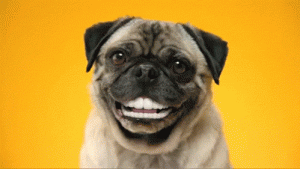
Did you know that 80% of dogs over the age of 4 have some form of dental disease?
As with people, the main culprit is a build-up of plaque, which eventually hardens into tartar, leading to gingivitis (inflammation of the gums) and periodontal disease.
The result? A bacterial invasion of the gums and tissues supporting the teeth, damaging them and ultimately causing tooth loss. This bacteria can also invade the bloodstream, potentially damaging the lungs, heart, kidneys and liver.
Did you know that, as responsible owners, you can lower your dog’s risks by following a program of conscientious oral care.
Before you start, have the vet examine your dog’s mouth for signs of hardened plaque and/or dental disease. If your dog suffers from either condition, once the dental disease is treated and/or the plaque professionally removed, your home care program can begin.
Ideally, you should begin caring for your dog’s teeth while he’s still a puppy. Brushing his teeth is the most effective way to control plaque by breaking it up before it hardens into tartar.
Choose only those toothbrushes, tooth pastes and oral gels designed especially for pets. For the more difficult ones, there are “rubber finger brushes.” If your dog refuses to accept any of these “tools,” use your own finger. It’s the act of brushing or rubbing which provides the most benefit.
Brush your dog’s teeth at the same time every day. Begin slowly, praising him often, stopping if he becomes agitated, then beginning again. Increase the amount of brushing time slowly, day by day.
If your dog absolutely refuses to have his teeth cleaned, add specially formulated antiseptic oral rinses (although they’re more effective when combined with cleaning) to his water.
Dogs love to chew, and this has the added benefit of helping to keep their teeth clean. There are dozens of specifically formulated oral care products for them, including dental chews, chew toys and treats.
There are also special dental diets shown to reduce plaque and/or tartar build up. They work by physically cleaning the teeth more efficiently than regular kibble (theirs is less likely to crumble upon chewing) or by the addition of chemicals to prevent the hardening of plaque into tartar.
Weekly inspections of your dog’s entire mouth can also help avoid both dental disease and costly and invasive medical procedures in the future. Ensure that your vet includes a thorough examination of your dog’s mouth, gums and teeth in each annual check up.
Be alert to such problems as bad breath, drooling, red or puffy, bleeding gums, yellow tartar crusted along the gum line, discolored, broken or missing teeth, bumps in the mouth, and changes in chewing or eating habits.
If you’ve been neglecting your dog’s dental health up to now, it is never too late to start.
Article by Nomi Berger

